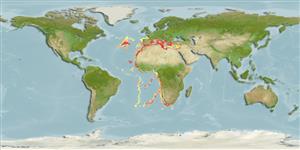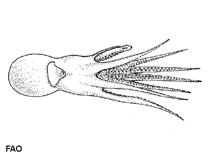Bathypolypus sponsalis (Fischer & Fischer, 1892)
Globose octopus| Native range | All suitable habitat | Point map | Year 2050 |

|
| This map was computer-generated and has not yet been reviewed. |
| Bathypolypus sponsalis AquaMaps Data sources: GBIF OBIS |
رده بندی / Names اسامي عام | مترادف | CoL | ITIS | WoRMS
Cephalopoda | Octopoda | Octopodidae | Bathypolypodinae
Environment: milieu / climate zone / تغييرات عمق / distribution range بوم شناسي
موجوداتی که در اعماق زیر 200 متر زندگی و تغذیه می کنند; تغييرات عمق 200 - 2300 m (مرجع 104052), usually 400 - 700 m (مرجع 1958). Subtropical; 12°C - ? (مرجع 1964)
Distribution كشورها | مناطق سازمان خوار و بار جهاني (FAO) | Ecosystems | ظهور | معرفي
Eastern Atlantic and the Mediterranean: Iberian Peninsula from Bay of Biscay to Cape Verde.
Length at first maturity / Size / Weight / سن
بلوغ: Lm ? range ? - ? cm Max length : 10.0 cm ML جنس نر / بدون خواص جنسي; (مرجع 104052)
Life cycle and mating behavior بلوغ | تولید مثل | تخم ریزی | Eggs | Fecundity | Larvae
مآخذ اصلی
مراجع | هماهنگ كننده | همكاران
Quetglas, A, M. Gonzales, A. Carbonell and P. Sánchez 2001 Biology of the deep-sea octopus Bathypolypus sponsalis (Cephalopoda: Octopodidae) from the wetern Mediterranean Sea. Mar. Biol. 138:785-792. (مرجع 1958)
وضعيت در فهرست قرمز IUCN
(مرجع 130435: Version 2025-1)
وضعيت از نظر سايتس (مرجع 108899)
CMS (مرجع 116361)
خطر برای انسان ها
استفاده انسانی
| FishSource |
ابزارها
اطلاعات بيشتر
منابع اينترنتي
BHL | BOLD Systems | CISTI | DiscoverLife | FAO(Publication : search) | Fishipedia | GenBank (ژنوم, نوکلئوتيد) | GloBI | Gomexsi | Google Books | Google Scholar | Google | PubMed | Tree of Life | Wikipedia (برو, جستجو) | Zoological Record



